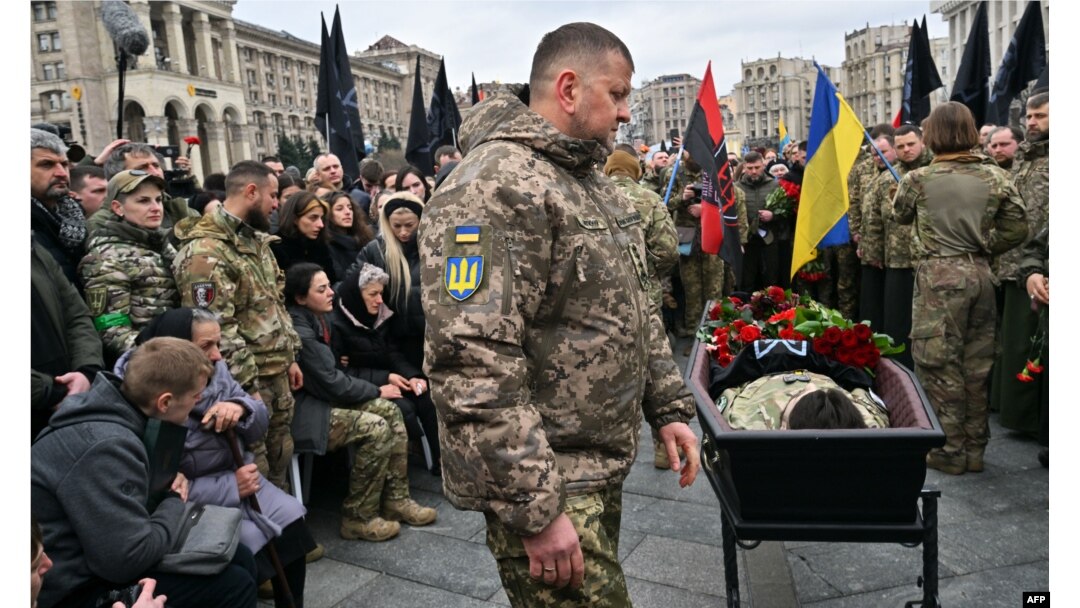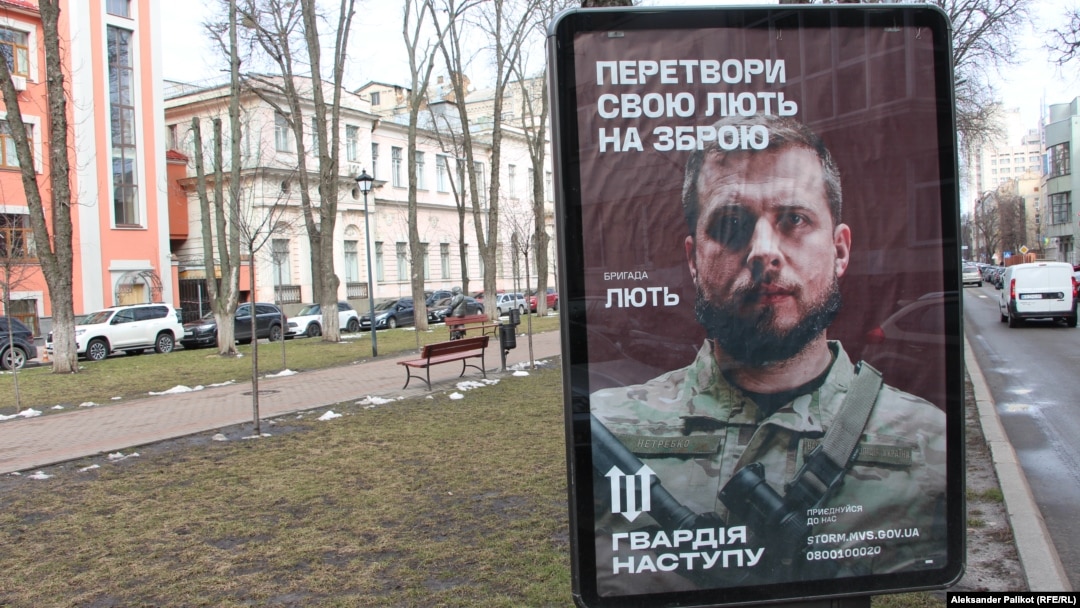KYIV -- On March 10, thousands of civilians and soldiers marched together through the central streets of the capital, chanting "Glory to Ukraine" and "Glory to the heroes" in a tribute to Dmytro Kotsyubaylo, the youngest commander ever to be decorated as a Hero of Ukraine and the first volunteer fighter to be granted the honor while still alive. Known by the call sign Da Vinci, he had been killed fighting Russian forces near Bakhmut, in the Donbas, three days earlier.
The images of senior leaders, including armed forces Commander in Chief General Valeriy Zaluzhniy, military intelligence chief Kyrylo Budanov, and Defense Minister Oleksiy Reznikov kneeling as they paid last respects to the 27-year-old soldier, have swiftly sunk deeply into the public consciousness. So have the tears of Kotsyubaylo's partner, Alina Mykhaylova, who is a paramedic in his unit, Da Vinci's Wolves, and a Kyiv city council member.
At the age of 18, Kotsyubaylo played an active part in the Euromaidan protests that pushed Moscow-friendly President Viktor Yanukovych from power in 2014. He took up arms when war between Moscow-backed separatists and Ukraine broke out in the Donbas shortly afterward -- and continued fighting following Moscow's large-scale invasion in February 2022.

The commander in chief of Ukraine's armed forces, Lieutenant General Valeriy Zaluzhniy, pays his respects during the farewell ceremony for Dmytro Kotsyubaylo on Independence Square in Kyiv on March 10.
His death and his mourning marked a transformative moment in Ukraine's resistance against the Russian invasion, and it underscored a stark reality: some of the most dedicated soldiers are dying, creating a dire need for others to fill their places.
As the grinding Russian offensive continues in the east, inflicting mounting losses on the military, many Ukrainians are hoping a counteroffensive that senior officials say is coming soon will be decisive in driving Russian forces back -- and ultimately out of the country.
Some are joining the Offensive Guard, a network of assault brigades being formed in the Interior Ministry as Ukraine readies for the expected push to retake Russian-occupied territory across the east and south.
The ministry has mounted a major recruiting campaign for the units. In streets, squares, and other spots around Kyiv, well-equipped, fit, and determined soldiers gaze at passersby from posters bearing slogans such as "It's time to get back what's yours" and "Join up." According to Interior Minister Ihor Klymenko, more than 28,000 people have volunteered to serve in the formation.
Top-Priority Project
The idea of the Offensive Guard was first discussed over six months ago by the Interior Ministry and President Volodymyr Zelenskiy's office, Deputy Interior Minister Kateryna Pavlichenko told RFE/RL. The aim of the project -- "a top priority for the ministry," she said -- is to create assault brigades combining the experience of seasoned soldiers with the determination of new volunteers.
Units of the Interior Ministry, especially the National Guard, have been fighting alongside the regular armed forces, which are under the Defense Ministry, since the February 2022 invasion -- and in some cases since the outbreak of the war in the Donbas in 2014.
Troops of the Bureviy Brigade train offensive operations during exercises in the Kyiv region.
"The experience of the de-occupation of the Kharkiv and Kherson regions showed that our troops are necessary on every phase of the hostilities and after them," Pavlichenko said, referring to counteroffensives in which Ukrainian forces retook large swaths of territory in the east and south last year. She said a substantial number of new members of the brigades were employees of Interior Ministry agencies who want to take part in the fighting.
The Offensive Guard consists of six brigades within the National Guard, including the Azov Brigade -- formerly Azov Regiment -- as well as one brigade each from the National Police and the Border Guards. Anyone can apply to a specific brigade online or in person at an office.
Following the rollout of a flashy and highly publicized recruitment campaign that was preceded by market research and developed by a creative agency with input from the presidential office, interest is high, and the Offensive Guard has nearly all the volunteers it needs for now, Pavlichenko said.
It will comprise tens of thousands of troops, she said, and the first of them will be ready to go to battle in early April.
In Training
On a training ground outside Kyiv this month, newcomers to the Bureviy Brigade -- Ukrainian for "storm," though some members say it's an acronym for Brigade for the Elimination of Russian Soldiers -- were being put through a comprehensive training program based on NATO standards, first on the individual, then group, and finally unit level, Kostyantyn Vakhramyeyev, commander of one of the brigade's battalions, told RFE/RL.
Now being replenished with new soldiers, the unit was involved in the crucial fighting in the Kyiv and Chernihiv regions at the beginning of the invasion, when Russian forces were stopped short of the capital and pushed back across the border, and in the unsuccessful defense of Syevyerodonetsk and Lysychansk in the Donbas later on. Some of its members are currently defending Bakhmut.
Kostyantyn Vakhramyeyev
After mastering firearms shooting, combat medicine, and operating various types of equipment, recruits practice offensive operations in conditions close to live battle. Some of the commanders and members of the brigade took part or are now taking part in training programs in Poland, Germany, or Britain.
The Bureviy Brigade has artillery, armored personnel carriers, and some tanks at its disposal. But Vakhramyeyev, who has been fighting since 2014, said that while the new personnel will be soon be "ready for the job," the unit will need "more heavy equipment, shells, and air support" to conduct major assaults.
Such challenges notwithstanding, two men who joined a month ago -- Dmytro Horditsa, a 41-year-old icon painter, and Denys Irzhytskiy, a 21-year-old medical student -- say they believe the Ukrainian counteroffensive will be a success.
"I'd had enough of being an observer," Horditsa said during a break from the training. He says he joined the Offensive Guard because he believes it is where "the best of those still in reserve come."
Dmytro Horditsa
Horditsa, who created hundreds of works of religious art in various styles throughout his artistic career, had zero military experience just a month ago: At draft age, he was exempted from conscription due to problems with his eyesight. Now these restrictions have been lifted, he says, and as his "art reached its logical conclusion" he decided to join up -- "as a real man must at this point."
He says he was glad his commanders were giving him time to train before going into combat, as "this is not always the case." Many of his friends are already fighting and some have been killed, he says.
Irzhytskiy says he joined up because he does not "want to lead an idle life when Russians are killing innocent people," and wants to be able to say he "took part in the victory after the war is over."
For a couple of months, he was a first-aid instructor in another unit, but he accepted an offer to move to the Bureviy Brigade because he believes it will enable him "to take part in a real fight." In a week, he was set to go to Britain for training, and after that he hopes to be deployed in the east.
Denys Irzhytskiy
Irzhytskiy chose the call sign Marabou -- a reference to a stork in a cartoon from his childhood who held the hand of a hippo that was afraid of injections.
"Even if I save one person, it will be a victory," he said.
Rebuilding The Military
The recruitment campaign for the Offensive Guard promises that its members will take part in the liberation of Russian-occupied territories, but the role its brigades will play during the counteroffensive is unclear.
Military expert Mykhaylo Zhirokhov told RFE/RL that the formation will likely play a supportive role while the regular armed forces will carry out the main thrust of the counteroffensive. Around 50,000 Ukrainian soldiers are being prepared for it in the rear and abroad, he said.
According to Zhirokhov, Russia's offensive in the east -- where Russian troops have been unsuccessfully trying to capture Bakhmut for over seven months -- has shown that "Moscow wants to impose World War II-era war logic, where whoever has more soldiers wins."
The Offensive Guard is primarily a "media campaign" because most of its brigades "are not created anew but simply rebranded," he said.
They are also being bolstered with new volunteers and new resources from the Interior Ministry -- a necessary process, as the ranks of those already fighting are depleted 13 months after the invasion.
Bureviy Brigade troops train in the Kyiv region.
"But in the end, we can't compete with Russia in numbers, and without a technological advantage, our [assault] troops find themselves in the position of Wagner soldiers around Bakhmut," he said, a reference to fighters from a notorious Russian mercenary group that has suffered massive losses.
Mykola Byelyeskov, an analyst at Ukraine's National Institute for Strategic Studies, told RFE/RL that creating the Offensive Guard fits into a historical pattern seen in many past wars when an army needs to be rebuilt after a year of fighting. Its creation, he adds, sends a good signal to Ukraine's international backers that "there is still a segment of society willing to join the fighting."
At the moment, Ukraine is forced to put its manpower under constant pressure to hold its positions, and the recruitment campaign of the Interior Ministry can compensate for some of the loses, but the success of the counteroffensive is predicated on the Ukrainian Army's ability to penetrate the tactical depths of Russian forces, he says.
According to Byelyeskov, Ukraine's push on the battlefield in the coming months is more likely to come in the form of persistent pressure on Russian targets, similar to advances in the Kherson region last autumn, than a lightning counteroffensive like the liberation of occupied parts of the Kharkiv region earlier in 2022.


